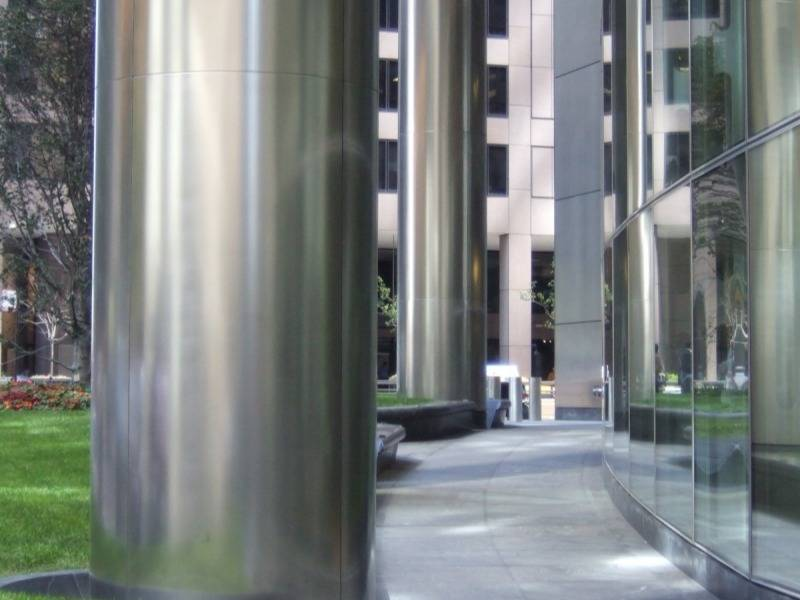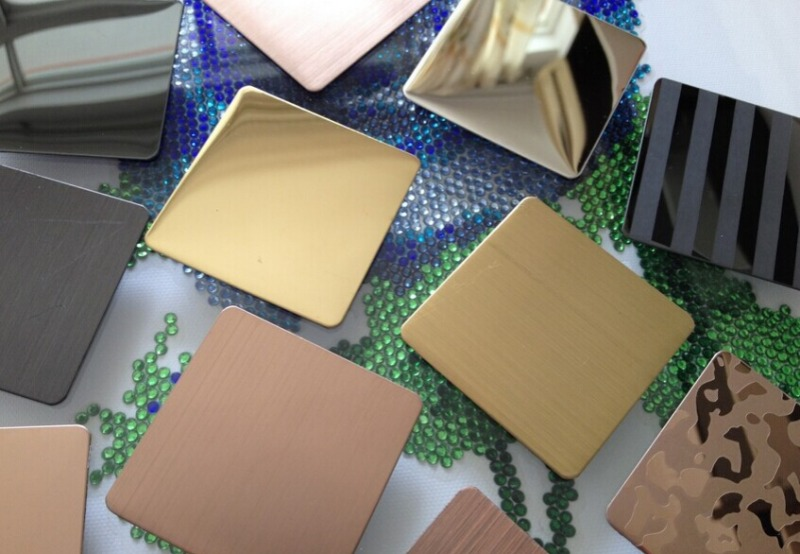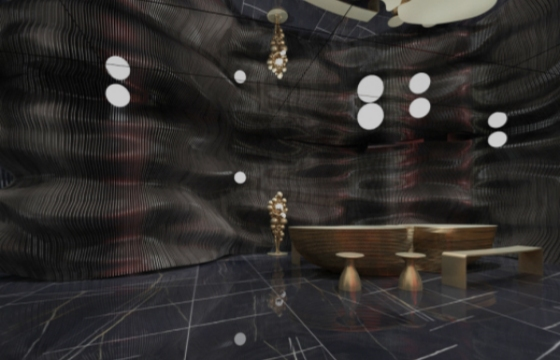When choosing stainless steel elevator doors for hotels, focus on both durability and appearance. High-traffic areas like lobbies need doors that resist scratches and fingerprints, while still looking stylish. PVD finishes are a smart choice if you want elegance that lasts without constant polishing.
1. Defining Hotel Requirements
1.1 Guest Experience Expectations
When selecting stainless steel elevator doors for a hotel, the first priority is how guests will perceive them. In luxury hotels, the lobby is the first touchpoint, and the elevator doors must align with the brand’s image. A brushed or gold PVD finish immediately conveys elegance, while a mirrored surface creates a modern, spacious feel. For example, in a five-star resort in Dubai, polished stainless steel doors were chosen to reflect ambient lighting, adding a dramatic effect to the lobby without looking overwhelming. The door finish is not just about durability—it’s part of the storytelling of the hotel.
1.2 Traffic Flow and Door Usage Frequency
Hotel elevators typically serve hundreds of guests per day, especially during check-in and breakfast hours. Choosing the right elevator door material ensures that constant use won’t lead to visible scratches or dents. Stainless steel is widely preferred because it balances strength with style. In high-traffic business hotels, anti-fingerprint coatings reduce cleaning frequency and keep the surface looking fresh even after thousands of touches. To visualize the difference in requirements, see the comparison below:
| Hotel Type | Guest Volume (per day) | Recommended Door Finish | Maintenance Frequency |
|---|---|---|---|
| Boutique Hotel (50–100 rooms) | 200–400 | Satin-finish stainless steel | Weekly deep clean |
| Business Hotel (200+ rooms) | 600–1,000+ | Anti-fingerprint stainless steel | Daily wipe-down |
| Luxury Resort | 300–600 | PVD-coated premium elevator doors | Twice-weekly polish |
1.3 Compliance with Hotel Design Standards
Every major hotel chain enforces strict design guidelines. Marriott, Hilton, and Hyatt all require elevator interiors and doors to match standardized finishes used across their global properties. Stainless steel sheets are often specified because they combine fire safety compliance with versatile design options. If a hotel owner wants to explore broader design applications beyond elevators, it’s worth looking into a full catalog of Stainless Steel Products to keep consistency across lobbies, handrails, and decorative panels. In practice, compliance doesn’t just protect the brand—it also reduces renovation costs, since standardized materials can be sourced and replaced quickly.
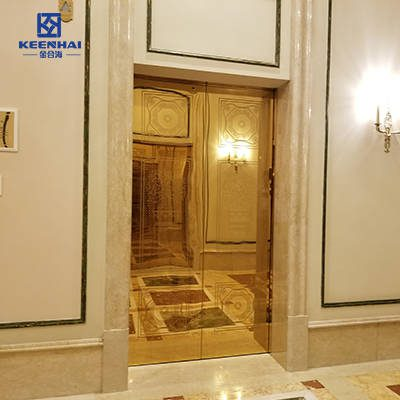
2. Material and Finish Options
2.1 Standard Stainless Steel Grades (304 vs 316)
When choosing stainless steel elevator doors for hotels, the steel grade determines how well the doors perform in daily use. Grade 304 is the industry standard in most commercial projects because it offers durability at a reasonable cost. Grade 316, however, contains added molybdenum, making it more resistant to corrosion, especially in coastal hotels where salty air accelerates wear. For instance, a beachfront resort in Miami opted for 316-grade doors because the lobby directly faces sea breeze exposure, while an urban business hotel in Chicago found 304 more than sufficient.
| Χαρακτηριστικό | 304 Ανοξείδωτο ατσάλι | 316 από ανοξείδωτο χάλυβα |
|---|---|---|
| Αντοχή στη διάβρωση | Good, suitable for most indoor hotels | Excellent, ideal for coastal or humid environments |
| Cost | Moderate | Higher (20–30% more expensive) |
| Common Application | Business hotels, boutique hotels | Resorts, seafront hotels, high-end projects |
2.2 PVD Coatings for Premium Aesthetics
Physical Vapor Deposition (PVD) coatings expand design possibilities beyond plain stainless steel sheets. Hotels use PVD finishes to achieve gold, bronze, or black tones without compromising strength. A luxury chain in Singapore applied gold-coated premium elevator doors for hotels, instantly aligning with their upscale brand identity. Unlike traditional paint or laminate, PVD bonds at a molecular level, so the color resists fading even after years of heavy use. This makes it a long-term investment for hotels that care about consistent aesthetics.
2.3 Anti-Fingerprint and Scratch-Resistant Treatments
One of the most practical concerns for hotel operators is keeping the door surface clean during peak hours. Anti-fingerprint finishes reduce visible smudges, which is especially useful in business hotels where dozens of guests use the elevator every five minutes. Scratch-resistant treatments also extend the life of the finish, minimizing the need for costly refurbishments. In a 400-room city hotel in Tokyo, management reported that switching to fingerprint-resistant panels cut cleaning time by almost 30% per day. For broader architectural applications beyond elevators, hoteliers can also explore Stainless Steel Sheets to achieve the same durability across wall claddings or decorative panels.
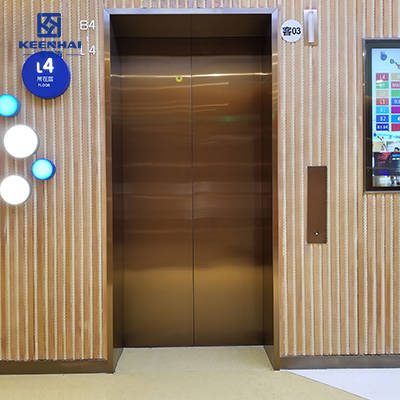
3. Design and Aesthetic Considerations
3.1 Matching Interior Themes and Lobby Style
Hotel lobbies are designed to make a lasting first impression, and the elevator doors need to integrate seamlessly with the chosen theme. A boutique hotel in Paris, for example, used satin-brushed stainless finishes to complement its Art Deco–inspired lobby, while a modern business hotel in Hong Kong installed premium elevator doors for hotels with mirrored panels to enhance the sense of space in a compact reception area. Designers often evaluate:
-
Color temperature of surrounding materials — Warm wood and gold tones pair better with bronze or champagne PVD finishes.
-
Lighting environment — High-gloss reflective surfaces amplify ambient lighting, whereas matte finishes diffuse brightness for a softer look.
-
Traffic pathways — Doors facing direct guest flow should use neutral metallic shades that resist visible wear, avoiding design distractions.
A well-matched elevator door doesn’t just “fit in”; it actively reinforces the visual rhythm of the space. This alignment with architectural details ensures that guests perceive consistency from the moment they step into the lobby.
3.2 Custom Patterns, Colors, and Textures
Hotels increasingly request custom finishes to differentiate themselves in competitive markets. Textured stainless steel sheets can mimic natural materials like stone or leather while maintaining the durability of metal. A luxury resort in Abu Dhabi commissioned gold-toned doors with wave patterns that echoed the desert dunes surrounding the property. Meanwhile, a Scandinavian hotel in Oslo preferred cool-toned stainless doors with vertical hairline textures to match its minimalist interior.
Customization doesn’t stop at texture—color variations created through PVD coatings offer designers a broader palette, from deep graphite black to rose gold. Hotels that host high-profile events often prefer bold tones to stand out in photographs and marketing materials. In these cases, it’s worth exploring a supplier’s broader catalog of Stainless Steel Products to ensure that wall panels, elevator interiors, and door surfaces all share the same design DNA.
To help designers visualize the options, here’s a quick comparison of commonly used finishes:
| Finish Type | Visual Effect | Typical Hotel Application |
|---|---|---|
| Brushed / Satin | Subtle, professional | Business hotels, airports |
| Mirror Polish | Reflective, spacious | Boutique hotels, high-rise towers |
| PVD Gold / Bronze | Luxurious, warm | Resorts, five-star lobbies |
| Textured Sheets | Unique, tactile | Themed hotels, destination properties |
3.3 Branding Opportunities with Laser Etching
For hotels that want to go beyond aesthetics, laser etching provides a direct way to incorporate branding into the elevator doors themselves. Logos, monograms, or even abstract patterns tied to a hotel’s identity can be permanently embedded into the stainless steel surface without affecting durability. A Hyatt property in Shanghai, for instance, etched its lotus emblem into the center panels of each door, ensuring brand recall with every guest interaction.
This approach offers three clear benefits:
-
Αντοχή — Unlike decals or vinyl overlays, etched logos never peel or fade.
-
Exclusivity — Hotels create a signature feature that can’t be easily replicated.
-
Consistency — The same etched design can be extended to wall panels, signage, or even banquet hall entrances.
Hotels considering laser etching often combine it with custom textures or PVD color layers for a multi-dimensional effect. When executed properly, branding through etching doesn’t just advertise the hotel name—it becomes a subtle, high-impact part of the guest experience.
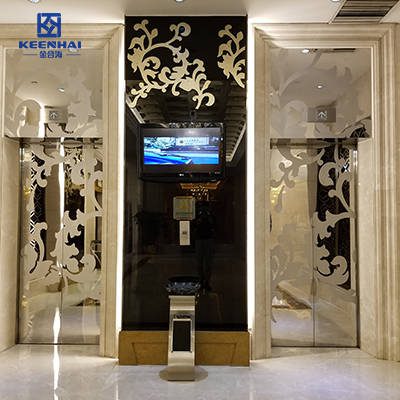
4. Durability and Maintenance Needs
4.1 Resistance to Corrosion and Wear
In hotel environments, elevator doors are exposed to constant contact from guests, staff, and luggage carts. This makes resistance to corrosion and surface wear a critical factor in material selection. Stainless steel excels in this area because of its chromium-rich surface, which naturally forms a passive oxide layer that prevents rusting even in humid or chemically treated environments. For high-end hotels located in coastal cities, where salt particles in the air accelerate corrosion, grades like 316 ανοξείδωτο ατσάλι are far more reliable than 304 due to their molybdenum content. The PVD (Physical Vapor Deposition) coating further improves resistance by creating a hard, scratch-resistant surface that preserves the door’s visual appeal longer than bare metal finishes. Hotels looking for a balance between cost and performance often weigh standard stainless steel against PVD-coated options, especially when considering long-term aesthetic preservation.
| Stainless Steel Option | Αντοχή στη διάβρωση | Scratch Resistance | Best Suited For |
|---|---|---|---|
| 304 Ανοξείδωτο ατσάλι | Good | Moderate | Indoor, low-humidity hotels |
| 316 από ανοξείδωτο χάλυβα | Excellent | Moderate | Coastal or humid regions |
| PVD-Coated Stainless | Excellent | High | Luxury hotels seeking durability and style |
4.2 Cleaning and Maintenance Frequency
Hotel elevators run daily without pause, and their doors are some of the most frequently touched surfaces. Choosing a finish that minimizes maintenance can drastically reduce operational costs. Brushed stainless steel hides fingerprints and smudges better than mirror-polished surfaces, making it ideal for high-traffic lobbies where appearance must be consistent throughout the day. However, mirror finishes are often chosen by luxury hotels for their premium look, which requires more frequent cleaning with non-abrasive products. The cleaning cycle typically depends on traffic levels: standard hotels may schedule once or twice daily cleanings, while 5-star properties often assign staff for continuous touch-ups. An antibacterial PVD finish is another option, especially for health-conscious hotel brands, as it reduces the risk of visible staining and microbial buildup, easing the cleaning burden over time.
4.3 Longevity in High-Traffic Environments
Durability isn’t just about corrosion resistance but also about how well the material performs after years of daily use. In hotels where thousands of guests pass through weekly, elevator doors must withstand bumps from luggage trolleys, scratches from keycards, and even spills from drinks. Stainless steel’s inherent hardness provides an advantage over softer materials like aluminum or wood veneers, which may dent or warp under repeated impact. With proper care, stainless steel doors can last 15–20 years without major refurbishment, whereas painted or veneered doors may require replacement within 5–10 years. PVD coatings extend longevity even further by protecting against micro-abrasions that dull the surface over time. For hotel managers, this translates into fewer renovation cycles, less downtime, and greater return on investment, making stainless steel a strategic long-term choice for high-traffic environments.
Explore our full collection of stainless steel products: www.pvdstainlesssteel.com











